English boxwood, a popular shrub in traditional gardens in
Virginia, and American boxwood, used in both traditional and contemporary
plantings, are susceptible to several diseases that can decrease their
effectiveness in established plantings. The most common and most important
diseases observed in boxwoods are root diseases that cause a gradual and
irreversible decline of the plant. A few minor stem and foliar diseases
occasionally also affect boxwoods. The major diseases of boxwood are discussed
below.
Root Diseases
Phytophthora Root Rot
|
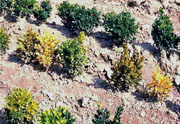
Fig. 1. Symptoms of Phytophthora root rot in the nursery.
(Photo by R. C. Lambe) |
Both English (Buxus sempervirens cv. 'Suffruticosa')
and American boxwood (B. sempervirens cv. 'Arborescens') are susceptible
to this disease, which is caused by the fungus Phytophthora parasitica.
The disease has also been observed in littleleaf boxwood (Buxus microphylla)
in Virginia. Aboveground symptoms include poor growth and off-color foliage.
Leaves are at first light green and may turn yellow, bronze, or straw-colored.
Leaves turn upward and lateral leaf margins roll inward. Leaf symptoms may
appear on just a few branches or on the entire plant, depending on the extent of
infection of the roots. Usually, the bark at the base of the infected plant dies
and can be easily separated from the wood. By the time foliar symptoms are
observed, roots are few in number and many are brown in color. The lack of
functioning roots precedes the yellowing and death of the top of the plant.
Control
Cultural Control
Plants growing in soils that have become water-logged
following overwatering or heavy rains in summer are predisposed to infection by
Phytophthora parasitica. Abundant moisture allows motile spores of the
fungus to move in the soil, infecting new roots on the same or adjacent plants.
New plantings should always be made with healthy appearing plants in
well-drained soil. Avoid planting a susceptible plant in infested soil unless
drainage can be improved prior to planting. Planting on raised beds may help
improve drainage around plants.
Chemical Control
Soil drench fungicides can be used to prevent disease on
plants that do not yet have severe root rot. After severely affected plants are
removed, soil around remaining plants or new transplants can be drenched with
mefenoxam (e.g. Subdue MAXX), metalaxyl (e.g. Subdue), fosetyl-Al (e.g. Aliette),
or etridiazole + thiophanate methyl (e.g. Banrot) at 4-week intervals. Consult
the product label or the current Virginia Pest Management Guide for
Horticultural and Forest Crops (VCE Publication 456-017), http://www.ext.vt.edu/pubs/pmg/,
for details on application rates. For information on the proper use of
pesticides and fungicides, refer to any current VCE pest management guide.
English Boxwood Decline
|
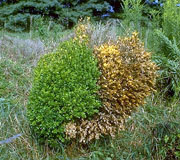
Fig 2. Foliar symptoms of English boxwood decline.
(Photo by R. C. Lambe)
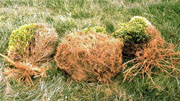
Fig. 3. Loss of fibrous roots due to English boxwood decline. Healthy
plant in the middle compared to plants with severe root rot on the sides.
(Photo by R. C. Lambe) |
The disease called English boxwood decline can best be
described as a slow but progressive decline occurring commonly in large plants
20 years or more in age. Decline symptoms resemble those of root rot caused by
Phytophthora parasitica. However, Phytophthora root rot is primarily a
problem in wet soils, whereas English boxwood decline often follows drought
stress. A complex of fungi has been associated with English boxwood decline, but
the fungus Paecilomyces buxi is believed to be the primary pathogen.
Plant parasitic nematodes have also been recovered from the roots of dying
plants, but not consistently enough to explain the disease.
External and internal stem discoloration usually accompanies
the root rot phase of the disease. Plants dying from decline have vascular
discoloration well up the main stem. The discoloration may be continuous or
discontinuous in the stem. Sections of the foliage of infected plants turn a
light green color. Later, foliage of infected plants turns yellow and then
straw-colored. By the time foliar symptoms are observed, the root system has
been severely impaired by root rot.
Disease Control
Every effort should be made to maintain plants in a high state
of vigor. Because drought stress is thought to be one of the main factors that
predisposes plants to disease, it is especially important to water plants deeply
and regularly during drought. Do not replant infested areas to English boxwood.
Both American boxwood and several cultivars of Buxus microphylla, tested
under field conditions, have been observed to be resistant to decline in field
tests and can be planted in areas where English boxwood decline has been
diagnosed. No fungicides have been found to be effective in controlling this
disease.
Root-Feeding Nematodes
|
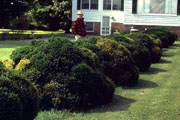
Fig. 4. Aboveground symptoms of nematode injury to English boxwood.
(Photo by R. C. Lambe) |
Damage to roots of both American and English boxwoods can
occur from the feeding of several types of plant parasitic nematodes. The most
common nematodes that feed on boxwood roots in Virginia are ring, lesion, and
spiral nematodes. These nematodes obtain nutrients by inserting their
syringe-like mouthparts into root cells and removing the contents. When
populations of any of these nematodes are high in soil, their feeding can cause
severe damage to roots and may also predispose roots to infection by fungi.
Symptoms on roots include stunting and browning. Aboveground symptoms resemble
those caused by root rot fungi: the plant undergoes a gradual decline
characterized by yellowing and bronzing of the leaves and dieback of large
sections of the plant.
Control
Cultural Control
There are no effective controls for nematodes on established
ornamental plants. Providing good growing conditions, e.g. fertilizing and
watering as necessary and providing good drainage, allows plants to tolerate
some root injury due to nematode feeding. Adding organic matter to the soil can
improve soil characteristics and encourage a diversity of microorganisms, some
of which will be antagonistic to nematodes.
Chemical Control
Chemical control involves use of soil fumigants, such as metam-sodium
(e.g. Vapam) or dazomet (e.g. Basamid), which are phytotoxic and must be applied
to soil before planting. Both of these materials must be applied under carefully
monitored soil conditions in order to be effective. Vapam is a restricted-use
pesticide and must be applied by a licensed applicator. Refer to the product
label for detailed instructions on use.
Biological Control
A new biological control product called Deny is reported to
control certain plant-feeding nematodes, including lesion and spiral nematodes.
This product consists of a bacterium that is antagonistic to certain plant
parasitic nematodes and fungi. Although specific studies with boxwood have not
been conducted, Deny has a broad label and is registered for use on all
ornamentals, as well as other crops, and may be an option for protection of new
transplants where lesion or spiral nematode damage has been diagnosed. Research
on other potential biological control agents is ongoing.
Foliar and Stem Diseases
Volutella Stem Blight
|
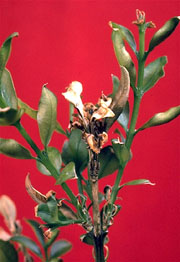
Fig. 5. Dieback symptoms of Volutella blight.
(Photo by R. C. Lambe)
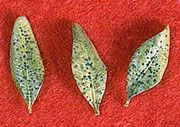
Fig. 6. Fruiting bodies of the fungus Macrophoma candollei on dead
boxwood leaves.
(Photo by R. C. Lambe) |
For several years, the role of the fungus Volutella buxi
in the decline of boxwood has been open to question. This fungus is asso-ciated
with wilt and canker, but its role as a primary pathogen has not been clearly
established. Both English and American boxwood have been found to develop
symptoms of Volutella stem blight.
In the spring, before the new growth appears, leaves on the
tips of twigs turn orange or bronze, then straw-colored. Infected twigs die back
for some distance. A dark brown to black canker is easily discernible after
cutting bark away with a sharp knife. The Volutella fungus produces
numerous clusters of conidia, which appear pink en masse. Winter injury causes
foliar symptoms similar to those caused by Volutella buxi, and
Volutella infection often follows winter or frost injury. If winter injury
alone is the problem, new, healthy leaves will appear in spring and eventually
hide the bronze-colored leaves.
Control
Prune out infected branches back to healthy tissue. Discard
all prunings. No fungicides have been shown to be effective in controlling this
disease.
Macrophoma Leaf Spot
Boxwood leaves that die as a result of various root diseases
or environmental stresses are frequently colonized by the fungus Macrophoma
candollei. This fungus produces numerous black fruiting bodies, which can be
seen as dark specks on dead leaves. It is a secondary colonizer of dead leaves
and its presence indicates that the plant is stressed by some other factor. No
controls for Macrophoma are recommmended; however, predisposing factors
should be addressed.
Other Leaf Disorders
Two symptoms on boxwood leaves to which no cause has been
attributed include a marginal yellowing on a normally green leaf, and an etching
of leaves with scattered, sunken tan spots. These symptoms occur sporadically
and do not appear to be a cause for concern.
Author: Mary Ann Hansen, Extension Plant Pathologist,
Department of Plant Pathology, Physiology and Weed Science, Virginia Tech
![]() Gardeners' Corner
Kids'
Garden
Sustainable Garden
Contact Us
Gardeners' Corner
Kids'
Garden
Sustainable Garden
Contact Us![]()







